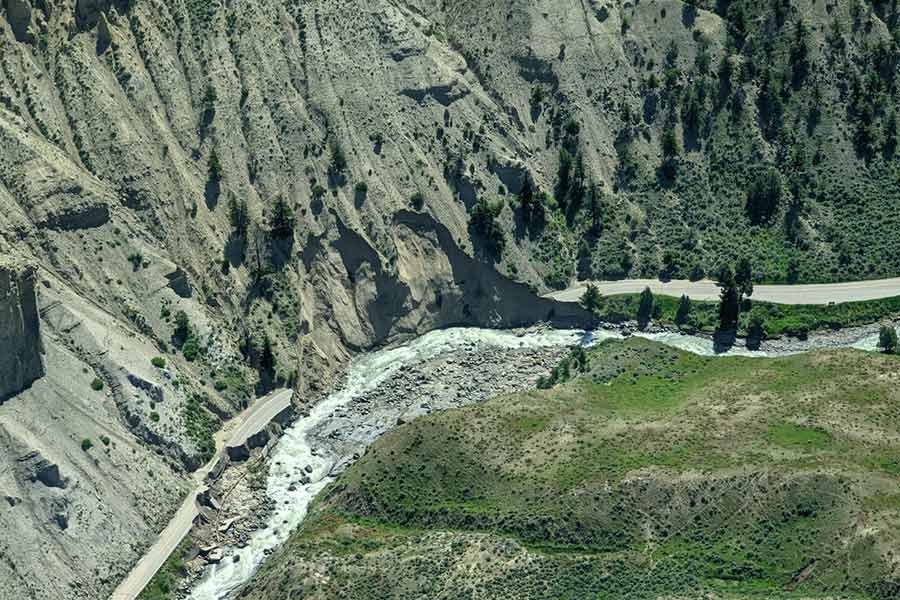On the night of June 12, 2022, a storm system began
dumping rain on the Beartooth Range of northern Wyoming and southern Montana.
Over the next 24 hours, about four inches fell on the still snow-covered peaks
of the northern Rockies. The rain-on-snow effect drove a rapid loss of mountain
snowpack. Because of this, streams and rivers quickly swelled out of their
banks, and quiet mountain towns were slammed with flash floodwaters. Bridges,
roads and homes in and around Yellowstone National Park were swept away in the
torrent, isolating communities and stranding tourists.
Teams of first responders were mobilized in the
hours and days after the disaster. Among them was a specialized group of
scientists who study civil infrastructure. “Our group of students and researchers
were loaded with scientific equipment and on the road in 24-hours after receiving
the call to help assess and map flood damage,” says Bret Lingwall, Ph.D., who
is an associate professor of civil and environmental engineering at South Dakota Mines.
Lingwall is one member of the National Science Foundation’s Geotechnical Extreme
Events Reconnaissance (GEER) effort. This organization includes teams of
scientists across the country who spring to action in the wake of disasters to
collect perishable post-disaster data. Their goal is to capture critical data
on infrastructure and disaster impacts that can be used to inform better
prevention and resiliency in the future.
GEER’s response to Yellowstone flooding was led by Anne
Lemnitzer at UC Irvine and Kevin Franke at Brigham Young University. They
called Lingwall and his students in to help. Lingwall says South Dakota Mines
had some important tools needed in the effort.
“Thanks to multiple donors and outside funding, we
have a fleet of drones and laser scanners across campus that are equipped for
detailed 3D mapping,” says Lingwall.
 Before drone and laser scanning (i.e. LiDAR)
technology, mapping was more tedious. Today, drones are equipped with high end cameras
and laser technology that can provide very accurate images and topographic
computer models. “We also maintain a pool of trained and FAA licensed drone
pilots, mostly students, who are ready to mobilize at any time for disasters
like this,” says Lingwall.
Before drone and laser scanning (i.e. LiDAR)
technology, mapping was more tedious. Today, drones are equipped with high end cameras
and laser technology that can provide very accurate images and topographic
computer models. “We also maintain a pool of trained and FAA licensed drone
pilots, mostly students, who are ready to mobilize at any time for disasters
like this,” says Lingwall.
The team drove to Gardner, Mont., set up a home base
and spent a week deploying drones to map both areas that were heavily damaged
by flooding and those that survived, despite the high water. “A lot of our work
is trying to determine why one piece of infrastructure failed in high-water and
why another one did not,” says Lingwall. Knowing what homes, roads and bridges crumbled and
knowing which structures remained can be highly valuable in the long-term
effort to build more robust infrastructure.
Lingwall says GEER’s report can also add to ongoing
research on things like slope stability and landslide reduction, bridge and
highway resiliency and home and building location. His students are using
samples collected during the flooding in their coursework that will add to
ongoing research. “The purpose of GEER is to collect this swath of perishable
data that will go away as soon as infrastructure is repaired. We use that data
to share with multiple agencies, highway departments, community planners,
engineers, emergency responders and others who can use the information to build
back in a way that will better survive the next disaster,” he says.
Lessons Learned
For Lingwall, the lessons of the floods that hit
Yellowstone include the need to update our standards. Current building codes
require designs that can withstand a 100-year flood event. “The next generation
of building codes, coming over the next 10 years, will require infrastructure
to withstand a 500- or 1000-year flood event,” Lingwall says. “In earthquakes,
we use a 2500-year criteria and this has done wonders for surviving these
events. Disasters like (the 2022) Yellowstone floods show that designing for a
100-year event was not the right criteria. It does not make sense.”
Developing more resilient infrastructure will save
taxpayer money in the long-term. “People
often only want to talk about up-front costs, and they will increase. What we
don’t like to talk about is what happens after the disaster hits and everyone
needs help from an agency like FEMA to recover. Building with more resiliency
in the beginning will save money down the road,” Lingwall says.
Lingwall points to towns like Rapid City, SD, which saw
a flash flood roar out the Black Hills and kill more than 230 people in 1972.
The city rebuilt in the wake of that disaster with an open floodway, including
multiple parks along Rapid Creek. But Lingwall points to USGS studies that show much larger floods in the
distant past on Rapid Creek than the 1972 disaster. “This is the
thing that terrifies me after seeing the flooding in Yellowstone,” he says.
“The paleo-flood record shows much bigger disasters than we have ever seen in
our collective memories as a community, are more than just possible in the
future, but likely.”
Lingwall notes that there are no easy solutions to
these challenges as socioeconomics play a big role in how and where we build in
the future. “These are decisions we have to adopt as communities,” he says.
You can hear a full
interview with Dr. Brett Lingwall on this topic on Ramblin' Wreck Research
Radio podcast here.